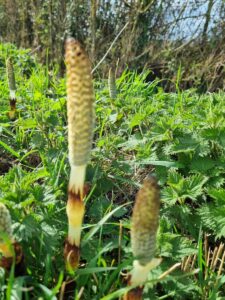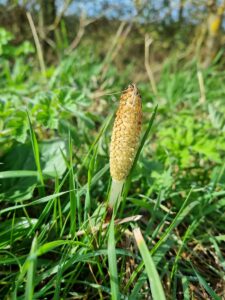In spring, specifically during the months of March and April, the emergence of Field Horsetail (Equisetum arvense) can be observed. Initially producing cones that contain spores. These structures, measuring approximately one centimetre in length, are affixed to fertile brown stems that sprout from the ground. These stems possess darker ridges, akin to the mighty Bamboo, turning green in the summer.
Field Horsetail Thrives in Damp Soil
Field Horsetail is a commonly found plant in the UK, not to be confused with ‘Mare’s Tail’ (Hippuris vulgaris) , flourishing in meadows, gardens, and abandoned areas. While it thrives in arable and grassy lands, it poses a particular challenge for perennial crops, fruit trees, and nursery stock. The presence of field horsetail can be detrimental to the growth of these plants. This resilient weed prefers damp soil for its growth.
Field Horsetail is Toxic to Livestock
It is important to note that Field Horsetail is toxic to livestock such as sheep, cattle, and horses, both in its green state and when dried and used as hay. Additionally, the related marsh horsetail, which is commonly found in wet, low-lying grasslands, also poses toxicity risks for livestock.
Extracts Proven to be Useful
One intriguing characteristic of horsetail is its ability to accumulate not only gold but also cadmium, copper, lead, and zinc in its tissues. The stems of this plant develop a rough and abrasive texture due to the accumulation of silica deposits. Field horsetail extracts have proven to be an effective fungicide, having been utilised for the treatment of blackspot on roses and rust in mint. Moreover, it possesses herbal properties, making it useful for various purposes.



Gardeners be Aware
A troublesome perennial weed that can quickly take over beds and borders, crowding out other plants. It spreads through rhizomes, which are underground stems, and forms dense stands of foliage. If you’re dealing with Field Horsetail in your garden, here are some options to consider.
Appearance-wise, Field Horsetail is easily recognisable by its upright shoots that resemble fir trees. In the spring, you’ll see light brown stems with cone-like spore-producing structures at the ends, standing at around 20-50cm (10-20in) tall. In the summer, the sterile green shoots grow into fir tree-like plants that can reach up to 60cm (2ft) in height.
The problem with horsetail lies in its creeping rhizomes, which can extend as deep as 2m (7ft) below the surface. This makes it difficult to remove by digging, especially if it has invaded a border. It often spreads from neighbouring gardens or land.
Conclusion
Control of horsetail is challenging. While shallow rhizomes near the surface can be forked out, deeper roots require extensive excavation. Simply chopping up the roots during shallow digging can worsen the problem, as the plant can regrow from small leftover pieces. However, removing shoots as soon as they emerge above the ground can help reduce infestation over time. If horsetail appears in lawns, regular mowing can help keep it in check.
Identifying the Field Horsetail at the spore stage is a good time to make a note of where the plant is growing, so you can start a control programme.
The Postcode Areas We Serve
Gloucester and Swindon
Birmingham and the Midlands
Bristol and the South West
Cardiff and South Wales










